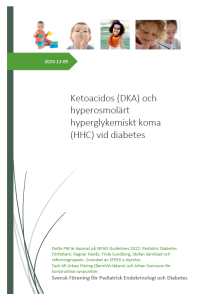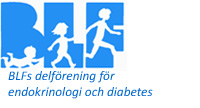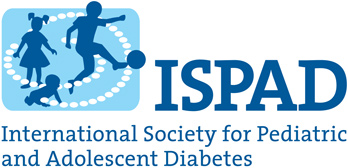| Revideras 2024 |
ISPAD Clinical Practice Consensus Guidelines 2022 |
|
1: Definition, epidemiology, and classification of diabetes in children and adolescents |
| 2: Stadieindelning av typ 1 diabetes hos barn och ungdomar |
2: Stages of type 1 diabetes in children and adolescents |
| 3: Typ 2 |
3: Type 2 diabetes in children and adolescents |
| 4: Monogen diabetes
Mer information om MODY |
4: The diagnosis and management of monogenic diabetes in children and adolescents |
| 5: Handläggning av cystisk fibros relaterad diabetes hos barn och ungdomar |
5: Management of Cystic Fibrosis-Related Diabetes in children and adolescents |
| 6: Utbildning i egenvård |
6: Diabetes Education in children and adolescents |
| 7: Diabetes vid öppenvårdsmottagningar |
7: The Delivery of ambulatory diabetes care to children and adolescents with diabetes |
| 8. Glykemiska mål och glukosmonitorering för barn och ungdomar med typ-1 diabetes |
8: Glycemic targets and glucose monitoring for children, adolescents, and young people with diabetes |
| 9: Insulinbehandling |
9: Insulin treatment in children and adolescents with diabetes |
| 10: Kost |
10: Nutritional management in children and adolescents with diabetes |
| 11.Ketoacidos |
11: Diabetic Ketoacidosis and Hyperglycemic Hyperosmolar State |
| Ketoacidos (DKA) och hyperosmolärt hyperglykemiskt koma (HHC) vid diabetes
Datum 2023-12-09 |
|
| 12: Hypoglykemi |
12: Assessment and management of hypoglycemia in children and adolescents with diabetes |
| 13: Interkurrent sjukdom |
13: Sick day management in children and adolescents with diabetes |
|
14: Exercise in children and adolescents with diabetes |
| 15: Psykosocialt stöd |
15: Psychological care of children, adolescents, and young adults with diabetes |
|
16: Diabetes Technologies: Glucose monitoring |
| 17: Tekniska hjälpmedel |
17: Diabetes Technologies – Insulin Delivery |
|
18: Microvascular and macrovascular complications in children and adolescents |
| 19: Associerade sjukdomar och andra komplikationer |
19: Other complications and associated conditions in children and adolescents with type 1 diabetes |
| 20: Kirurgi |
20: Management of children and adolescents with diabetes requiring surgery |
| 21: Adolescens |
21: Diabetes in Adolescence |
| 22: Diabetes i skolan |
22: Management and support of children and adolescents with type 1 diabetes in school |
| 23: Förskolebarn |
23: Managing Diabetes in Preschoolers |
| 24: Ramadan och annan religiös fasta |
24: Ramadan and other religious fasting by young people with diabetes |
| 25. Behandling av diabetes när resurserna är begränsade |
25: Management of the child, adolescent, and young adult with diabetes in limited resource settings |
|
| MiniMed 670g, hybrid closed loop insulinpump NT-råd…. /2018-11-15 |
Datum 2019-02-21 |
 |
Behandlingsstrategi typ 1-diabetes barn och ungdomar© Sveriges Kommuner och Landsting, 2017,
Best.nr: 5336
Redaktör: Annelie Petersson
Produktion: KombineraDatum 2018-11-21 |
| Egenvardsplan-diabetes-skola 3.0 final |
Datum 2024-01-21 |
| Egenvårdsplan-diabetes- förskola 2.0 final |
Datum 2024-01-21 |
| Bilaga till läkarutlåtande för omvårdnadsbidrag vid diabetes hos barn och ungdomar |
Datum 2020-03-10 (stavfel rättat 20-09-28) |
 |
Ketoacidos (DKA) och hyperosmolärt hyperglykemiskt koma (HHC) vid diabetes
Datum 2023-12-09 |





forum Kommentarer
Hej!
Fint med uppdaterat DKA-PM!!
Dock så undrar jag om snabb rehydrering för vikterna 45-80 kg blev rätt? Nu ska en 80 KG person rehydreras med 1000 ml/tim…
MVH
Torun
Torun Tobjörnsdotter
, 25 maj, 2021 |Hej Torun,
Fint att du läser noggrant! Ja, det är 12,5 ml/kg som ges i 1, max 2 tim.
Men redan 2018 hade vi tagit bort spärren på vätska för de som väger lite mer. Se dock brasklappen ang. obesa patienter.
Om du hittar en annan tabell i en Akutpediatrikbok så är denna för gammal och bör slängas!
Vänl hälsn,
Ragnar
PS Svarade i början på juni men det tycks ha kommit bort
Ragnar Hanås
, 23 juni, 2021 |